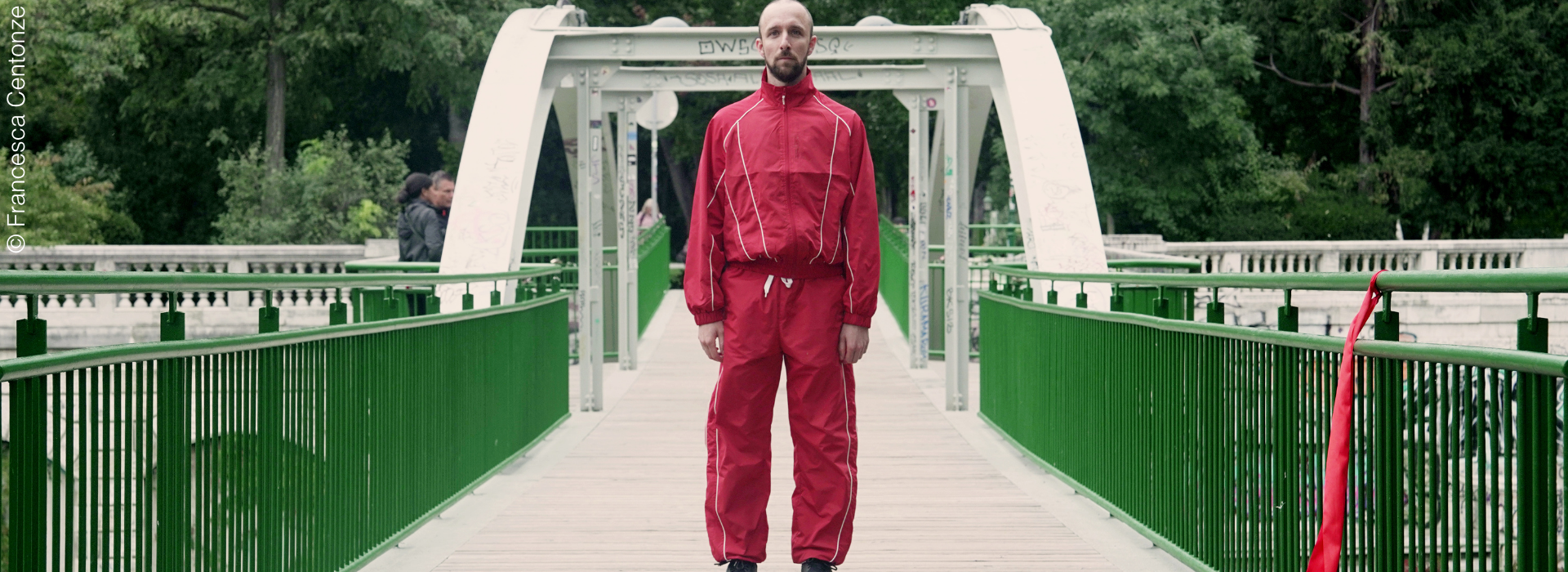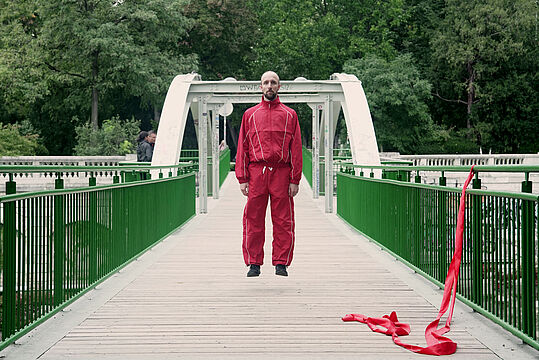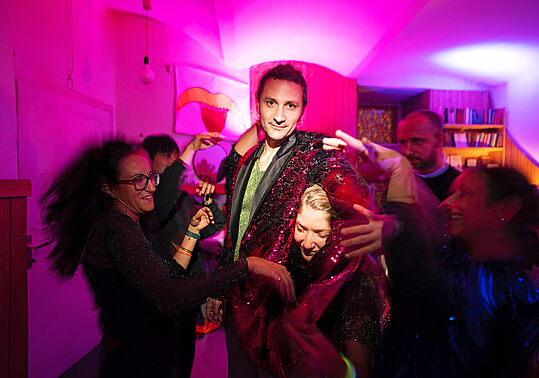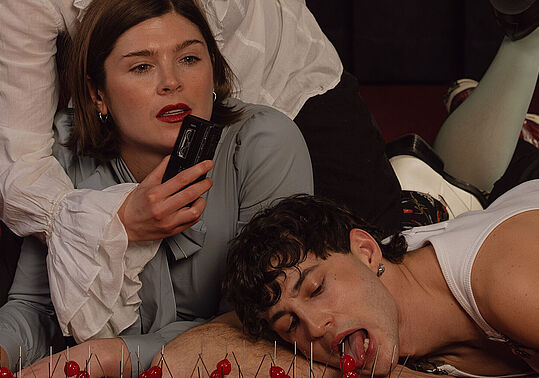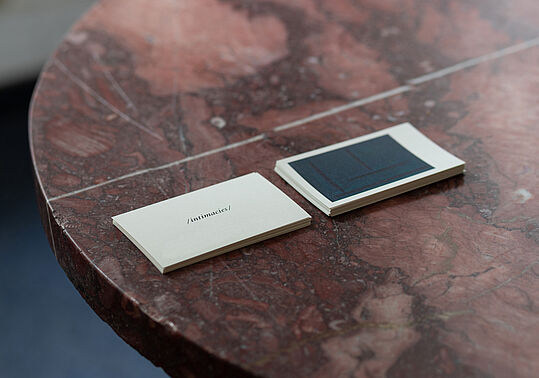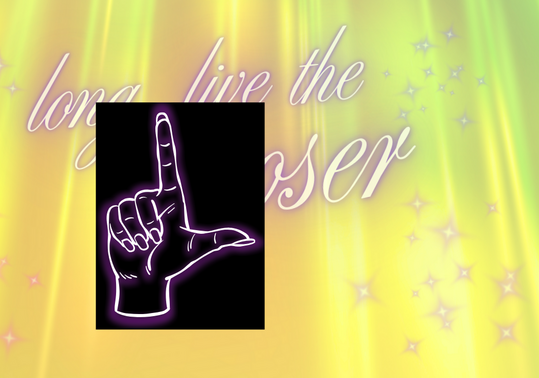What happens when we stop?
Lesezeit: ca. 6 Minuten
In conversation with Alberto Cissello, the artist reflects on the potency of the pause, the tenderness of suspense and the unexpected clarity that can arise when we allow ourselves to remain in stillness for longer than we usually dare.
A piece that lingers in the in-between, inviting us to notice what lives inside an empty moment.
The title of your work refers to a mime technique — fixing an imaginary point in space to make something invisible become present. What drew you to this idea, and how did it become the conceptual and physical anchor for the piece?
I chose the title POINT FIXE as an homage to mime, an art form I feel intuitively connected to, even though I have never been formally trained in it. When I watch mimes perform, I am fascinated by their ability to make something invisible feel real— like watching an illusion. Simple gestures, like placing a hand on an invisible wall or pulling an imaginary rope, invite me as a viewer to bridge the gap between what is there and what is not.
I love this mechanism, and I began to see it as a metaphor for perception itself: I make up meanings, stories, and images from fragments of what I see.
While exploring this technique in the studio, what truly compelled me was the realization that open meanings arise even more strongly from what is left undone—from stillness, from quietness, especially when I remain exposed to it long enough. This awareness became an urgency for me: to explore how my relationship with what is not happening exposes me to a myriad of interpretations and, inevitably, confronts me with myself—my patterns and the emotional after-effects they produce.
A blank canvas allows for far more projection than a hyper-realistic landscape. In a blank canvas, I am more likely to sense and observe intimate sides of myself, because it offers an open device—a space where meaning unfolds in its own time. Mime performance, while often appearing very literal, offered me a technical device to explore how my interaction with absence exposes me to myself—to my thoughts and projections—and I wanted to bring that exploration into a shared theatrical environment, becoming a flexible device in which the audience can also project themselves.
You describe the piece as a “conversation with emptiness.” How do you approach emptiness or absence in your practice? Is it something to resist, to embrace, to play with?
I think all these possibilities—resistance, embrace, play—come from the same experience I wish to bring on stage.
I consider myself a very social person, and I have often noticed how I feel when I am alone. For example, when my partner leaves for a few days, the flat suddenly feels empty. I am so used to her presence that, in her absence, I feel it immediately. But before I fully recognize any emotions that arise, there is a brief suspension—an “ah” moment—when I notice the quiet around me. That moment is central to the creation of the piece.
In that quietness, I notice myself, and the emotions that follow can vary widely: panic, nostalgia, peace or relief. This very human mix of feelings—emerging when I am suddenly alone—is what drives POINT FIXE. I realize I crave alone time, yet when it comes, I panic, reaching for my phone or turning on music.
With this piece, I don’t aim to glorify “doing nothing”. Rather, I want to draw attention to how stillness, quietness, absence expose something intimate about ourselves, which is ultimately what connects us to others in my opinion.
In the studio, I explored this quietness intentionally. Initially I was deeply inspired by Bruce Nauman’s early work, especially his film Walking in an Exaggerated Manner Around the Perimeter of a Square. Nauman’s walking, repetition, and minimal choreography transformed a mundane action into a rigorous inquiry. This work questions, in my view, productivity, presence, and the value of “just being” in space.
Inspired by this, I experimented with pauses, repetition, choreographic structures, movement without music, and solitude in the rehearsal spaces. I tracked where my thoughts went, how my attention shifted, what I wanted to do—and what I didn’t want to do. Gradually, with the team supporting me, we shaped a performance that centers on what is not happening and what is not there, making absence and quiet a space for exploration for both me and the audience.
There are moments in the performance where humor subtly emerges, even in stillness or hesitation. How do you understand the relationship between humor and suspense, or between action and inaction?
The first connection I see between humor and suspense is embarrassment. It can be uncomfortable to find yourself in quietness with someone you don’t know well. This experience has many shades—cultural, personal, situational. For instance, if I imagine two people sharing an elevator moment without knowing what to say, there is a tender humor in that feeling of clumsiness. Ten seconds in an elevator can feel like forever.
I am aware that this is only one perspective, closely tied to my context. Humor, tension, and embarrassment play differently across cultures and situations.
Stopping, in life and on stage, feels increasingly rare in a world obsessed with speed and productivity. Do you see Point Fixe as having a particular resonance with our current moment?
The most intuitive answer is yes. Stopping can have a profound effect on us, especially in a contemporary Western context where speed and productivity are equated with value. I immediately think of what many friends and colleagues described during the first lockdown in Austria in March 2020. For some, it was an almost strange relief to feel tasks, deadlines, and professional responsibilities pause.
This relief came from a temporary suspension of the pressure to keep up, to avoid missing out, to do enough. Overnight, there was little to “miss,” because staying home was the only possibility—at least in the early phase of the lockdown. I do not mean to suggest it was an easy moment, but that relief revealed something deep about the toxicity of constant obligation in our society.
At the same time, I am highly aware of the privileges embedded in this experience. The ability to stop and to have shelter, food, and safety is far from universal. Many people around the world, and even within my own society, do not have the luxury to pause; lives are threatened, obligations are urgent, and quiet moments are rare or impossible. My reflections come from a specific position.
Yet what I notice—around me and within me—is a pervasive anxiety I relate to the experience of horror vacui: the fear of emptiness, of the unfilled moment, and how it shapes social life, relationships, and mental health. In that quietness, in that void, I sense something profoundly human—the same force that connects me to others, beyond words or explanation. It is strange that, in a society where basic needs are largely met, invisible pressures still weigh heavily on us—in the digital world, in our perception of ourselves, and in the value we assign to productivity and image.
POINT FIXE does not glorify stillness, nor does it romanticize slowness. On stage, I use the intervals between actions and scenes as intense forms of exposure for me. Entering and remaining still is not meant to be a provocation, but an invitation to perceive, to feel what arises in that shared, quiet space.
Zu allen Artikeln

